service indicator BMW M5 SEDAN 2016 Owners Manual
[x] Cancel search | Manufacturer: BMW, Model Year: 2016, Model line: M5 SEDAN, Model: BMW M5 SEDAN 2016Pages: 239, PDF Size: 5.04 MB
Page 61 of 239
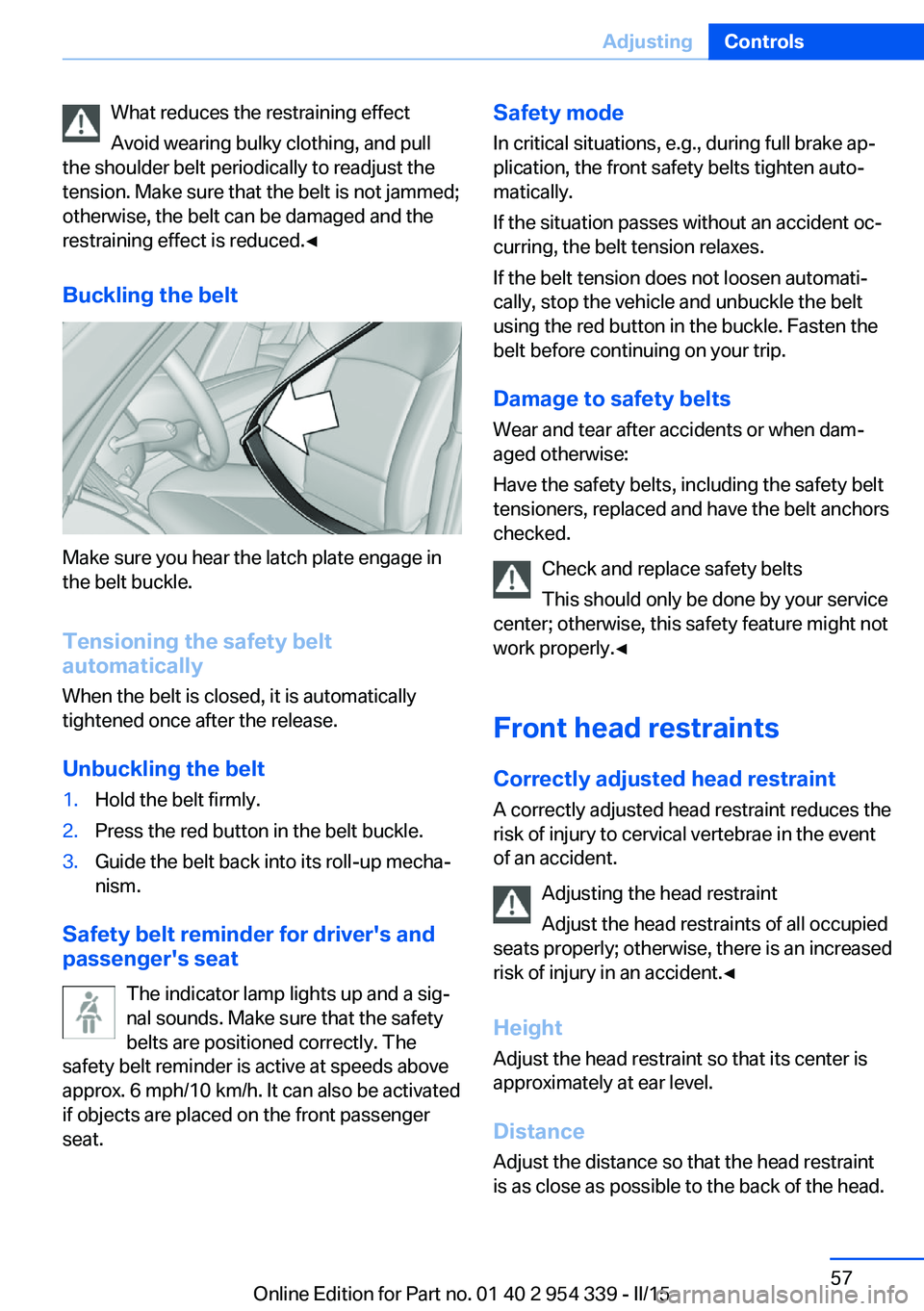
What reduces the restraining effect
Avoid wearing bulky clothing, and pull
the shoulder belt periodically to readjust the
tension. Make sure that the belt is not jammed;
otherwise, the belt can be damaged and the
restraining effect is reduced.◀
Buckling the belt
Make sure you hear the latch plate engage in
the belt buckle.
Tensioning the safety belt
automatically
When the belt is closed, it is automatically
tightened once after the release.
Unbuckling the belt
1.Hold the belt firmly.2.Press the red button in the belt buckle.3.Guide the belt back into its roll-up mecha‐
nism.
Safety belt reminder for driver's and
passenger's seat
The indicator lamp lights up and a sig‐
nal sounds. Make sure that the safety
belts are positioned correctly. The
safety belt reminder is active at speeds above
approx. 6 mph/10 km/h. It can also be activated
if objects are placed on the front passenger
seat.
Safety mode
In critical situations, e.g., during full brake ap‐
plication, the front safety belts tighten auto‐
matically.
If the situation passes without an accident oc‐
curring, the belt tension relaxes.
If the belt tension does not loosen automati‐
cally, stop the vehicle and unbuckle the belt
using the red button in the buckle. Fasten the
belt before continuing on your trip.
Damage to safety beltsWear and tear after accidents or when dam‐
aged otherwise:
Have the safety belts, including the safety belt
tensioners, replaced and have the belt anchors
checked.
Check and replace safety belts
This should only be done by your service
center; otherwise, this safety feature might not
work properly.◀
Front head restraints Correctly adjusted head restraint
A correctly adjusted head restraint reduces the
risk of injury to cervical vertebrae in the event
of an accident.
Adjusting the head restraint
Adjust the head restraints of all occupied
seats properly; otherwise, there is an increased
risk of injury in an accident.◀
Height
Adjust the head restraint so that its center is
approximately at ear level.
Distance Adjust the distance so that the head restraint
is as close as possible to the back of the head.Seite 57AdjustingControls57
Online Edition for Part no. 01 40 2 954 339 - II/15
Page 88 of 239
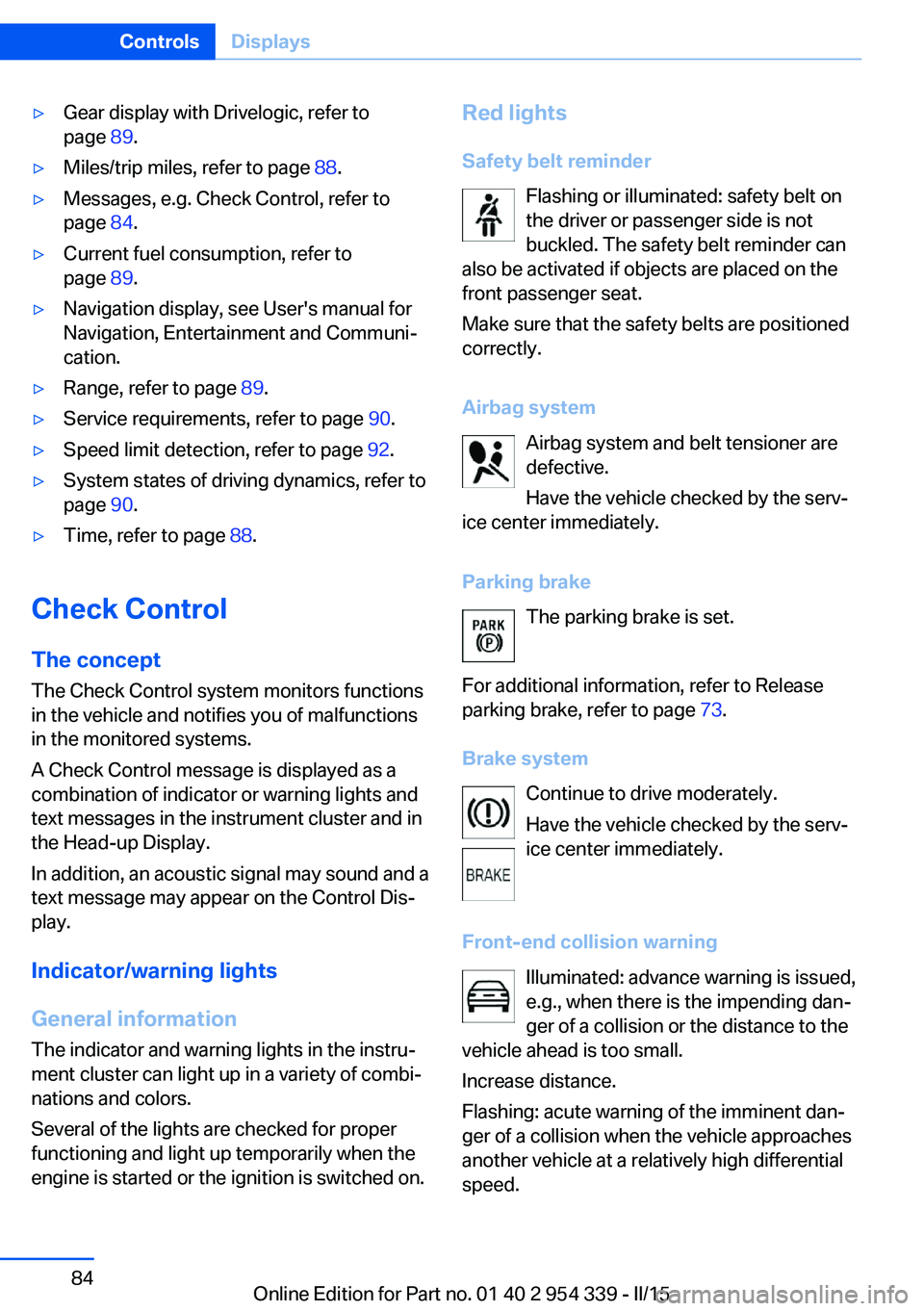
▷Gear display with Drivelogic, refer to
page 89.▷Miles/trip miles, refer to page 88.▷Messages, e.g. Check Control, refer to
page 84.▷Current fuel consumption, refer to
page 89.▷Navigation display, see User's manual for
Navigation, Entertainment and Communi‐
cation.▷Range, refer to page 89.▷Service requirements, refer to page 90.▷Speed limit detection, refer to page 92.▷System states of driving dynamics, refer to
page 90.▷Time, refer to page 88.
Check Control
The concept The Check Control system monitors functions
in the vehicle and notifies you of malfunctions
in the monitored systems.
A Check Control message is displayed as a
combination of indicator or warning lights and
text messages in the instrument cluster and in
the Head-up Display.
In addition, an acoustic signal may sound and a text message may appear on the Control Dis‐
play.
Indicator/warning lights
General information
The indicator and warning lights in the instru‐
ment cluster can light up in a variety of combi‐
nations and colors.
Several of the lights are checked for proper
functioning and light up temporarily when the
engine is started or the ignition is switched on.
Red lights
Safety belt reminder Flashing or illuminated: safety belt on
the driver or passenger side is not
buckled. The safety belt reminder can
also be activated if objects are placed on the
front passenger seat.
Make sure that the safety belts are positioned
correctly.
Airbag system Airbag system and belt tensioner are
defective.
Have the vehicle checked by the serv‐
ice center immediately.
Parking brake The parking brake is set.
For additional information, refer to Release
parking brake, refer to page 73.
Brake system Continue to drive moderately.
Have the vehicle checked by the serv‐
ice center immediately.
Front-end collision warning Illuminated: advance warning is issued,
e.g., when there is the impending dan‐
ger of a collision or the distance to the
vehicle ahead is too small.
Increase distance.
Flashing: acute warning of the imminent dan‐
ger of a collision when the vehicle approaches
another vehicle at a relatively high differential
speed.Seite 84ControlsDisplays84
Online Edition for Part no. 01 40 2 954 339 - II/15
Page 90 of 239
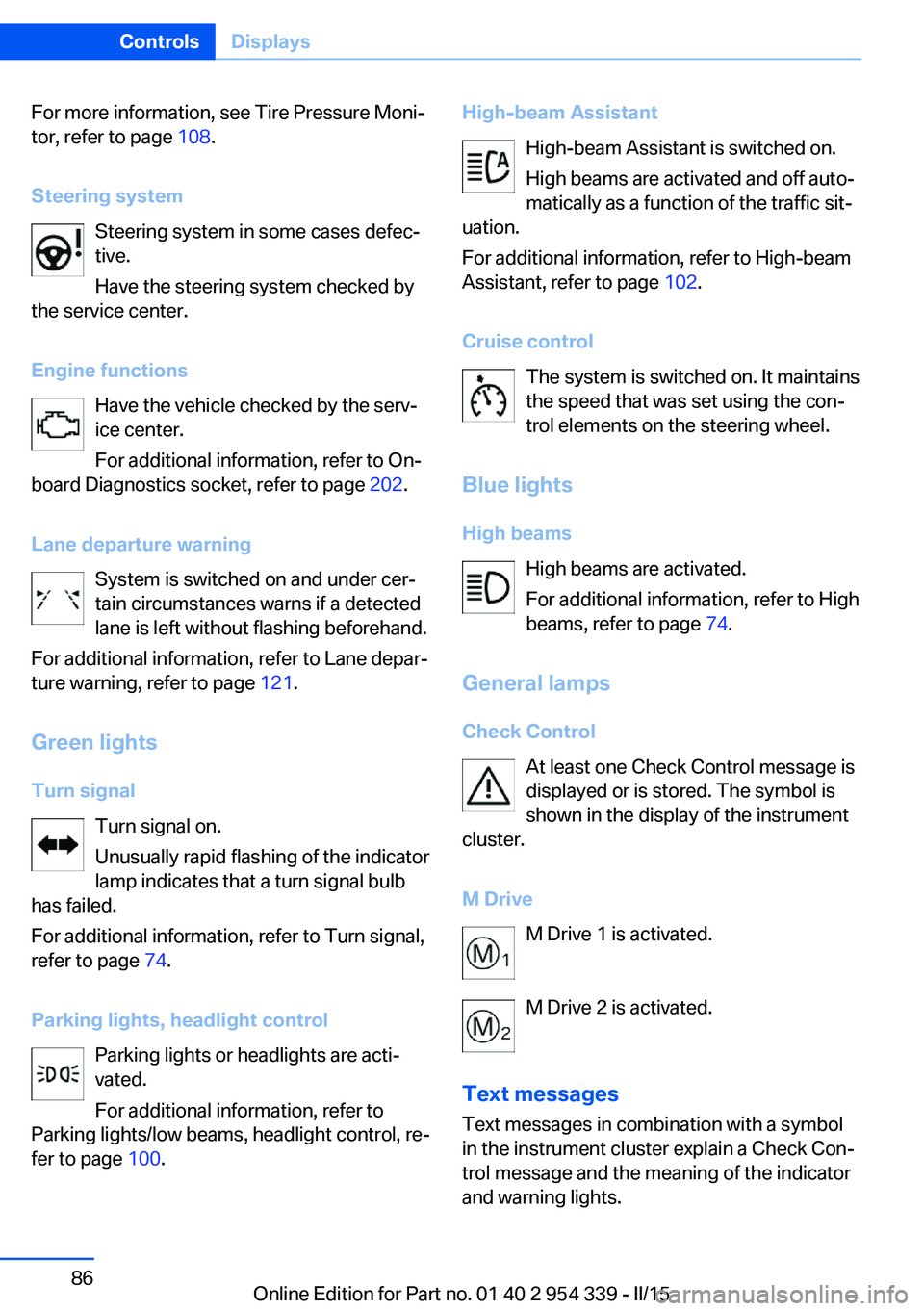
For more information, see Tire Pressure Moni‐
tor, refer to page 108.
Steering system Steering system in some cases defec‐
tive.
Have the steering system checked by
the service center.
Engine functions Have the vehicle checked by the serv‐ice center.
For additional information, refer to On-
board Diagnostics socket, refer to page 202.
Lane departure warning System is switched on and under cer‐
tain circumstances warns if a detected
lane is left without flashing beforehand.
For additional information, refer to Lane depar‐
ture warning, refer to page 121.
Green lights Turn signal Turn signal on.
Unusually rapid flashing of the indicator
lamp indicates that a turn signal bulb
has failed.
For additional information, refer to Turn signal,
refer to page 74.
Parking lights, headlight control Parking lights or headlights are acti‐
vated.
For additional information, refer to
Parking lights/low beams, headlight control, re‐
fer to page 100.High-beam Assistant
High-beam Assistant is switched on.
High beams are activated and off auto‐
matically as a function of the traffic sit‐
uation.
For additional information, refer to High-beam
Assistant, refer to page 102.
Cruise control The system is switched on. It maintains
the speed that was set using the con‐
trol elements on the steering wheel.
Blue lights
High beams High beams are activated.
For additional information, refer to High
beams, refer to page 74.
General lamps
Check Control At least one Check Control message is
displayed or is stored. The symbol is
shown in the display of the instrument
cluster.
M Drive M Drive 1 is activated.
M Drive 2 is activated.
Text messages Text messages in combination with a symbol
in the instrument cluster explain a Check Con‐
trol message and the meaning of the indicator
and warning lights.Seite 86ControlsDisplays86
Online Edition for Part no. 01 40 2 954 339 - II/15
Page 95 of 239
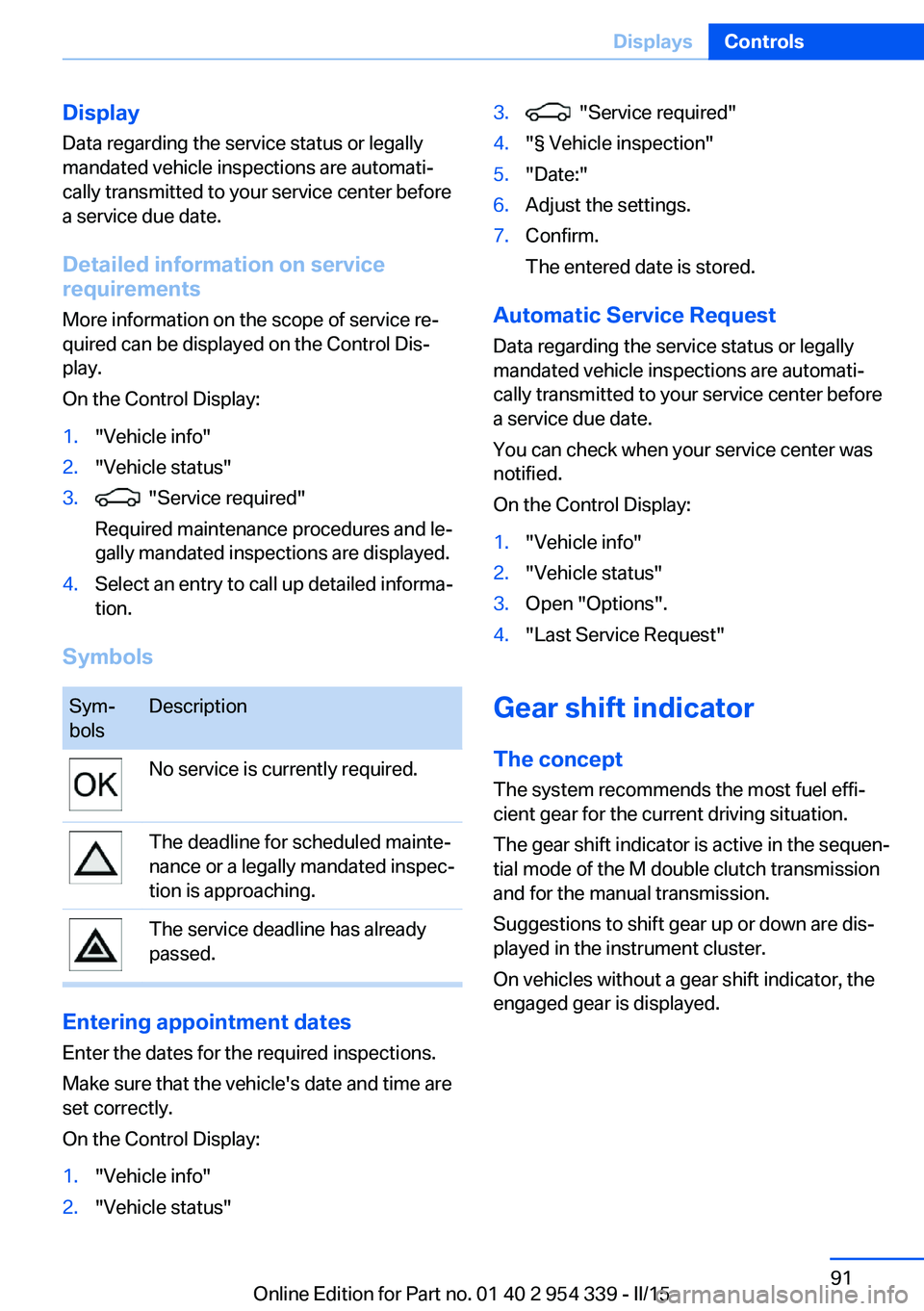
Display
Data regarding the service status or legally
mandated vehicle inspections are automati‐
cally transmitted to your service center before
a service due date.
Detailed information on service
requirements
More information on the scope of service re‐
quired can be displayed on the Control Dis‐
play.
On the Control Display:1."Vehicle info"2."Vehicle status"3. "Service required"
Required maintenance procedures and le‐
gally mandated inspections are displayed.4.Select an entry to call up detailed informa‐
tion.
Symbols
Sym‐
bolsDescriptionNo service is currently required.The deadline for scheduled mainte‐
nance or a legally mandated inspec‐
tion is approaching.The service deadline has already
passed.
Entering appointment dates
Enter the dates for the required inspections.
Make sure that the vehicle's date and time are
set correctly.
On the Control Display:
1."Vehicle info"2."Vehicle status"3. "Service required"4."§ Vehicle inspection"5."Date:"6.Adjust the settings.7.Confirm.
The entered date is stored.
Automatic Service Request
Data regarding the service status or legally
mandated vehicle inspections are automati‐
cally transmitted to your service center before
a service due date.
You can check when your service center was
notified.
On the Control Display:
1."Vehicle info"2."Vehicle status"3.Open "Options".4."Last Service Request"
Gear shift indicator
The conceptThe system recommends the most fuel effi‐
cient gear for the current driving situation.
The gear shift indicator is active in the sequen‐
tial mode of the M double clutch transmission
and for the manual transmission.
Suggestions to shift gear up or down are dis‐
played in the instrument cluster.
On vehicles without a gear shift indicator, the
engaged gear is displayed.
Seite 91DisplaysControls91
Online Edition for Part no. 01 40 2 954 339 - II/15
Page 103 of 239
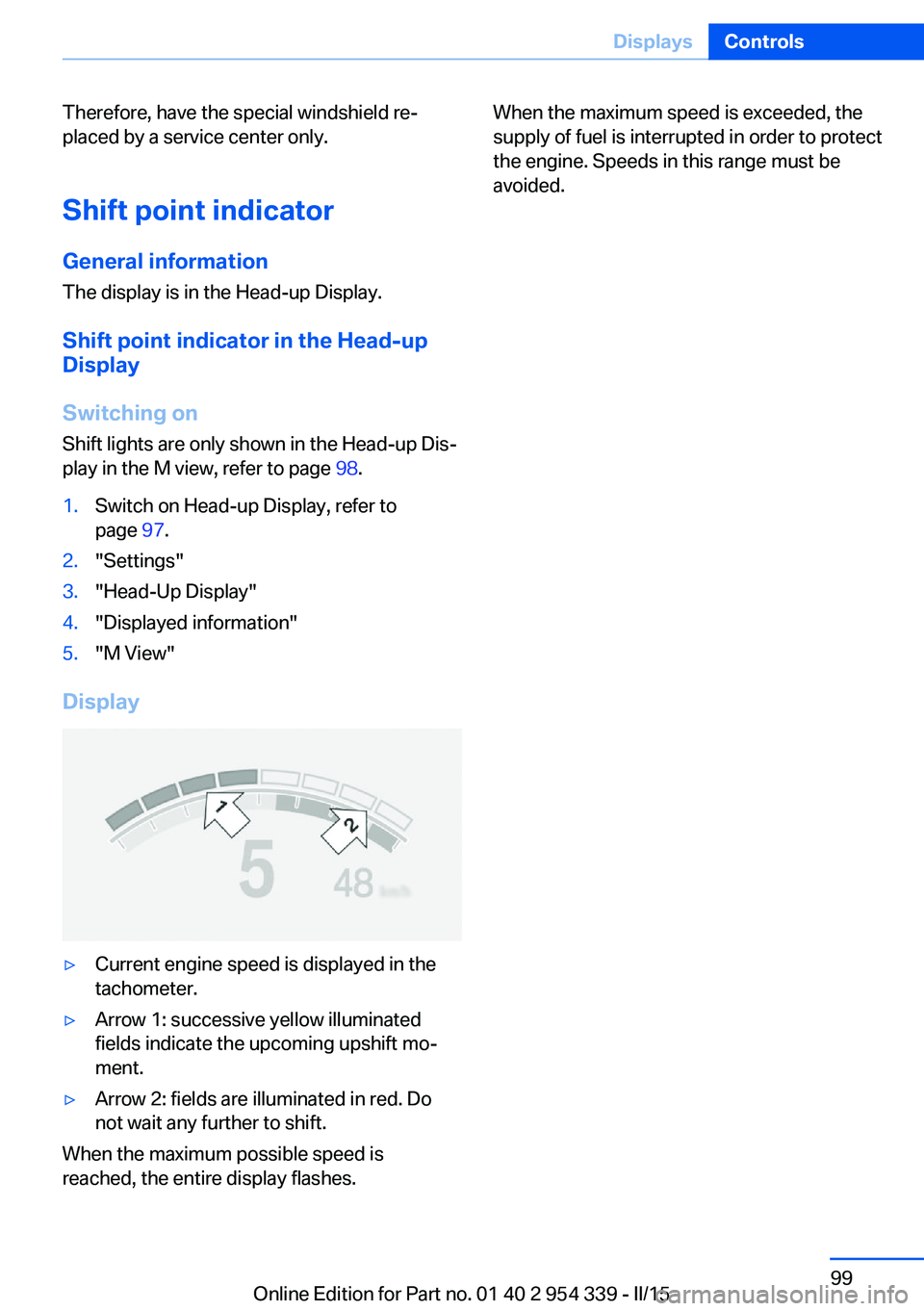
Therefore, have the special windshield re‐
placed by a service center only.
Shift point indicator General information
The display is in the Head-up Display.
Shift point indicator in the Head-up
Display
Switching on Shift lights are only shown in the Head-up Dis‐
play in the M view, refer to page 98.1.Switch on Head-up Display, refer to
page 97.2."Settings"3."Head-Up Display"4."Displayed information"5."M View"
Display
▷Current engine speed is displayed in the
tachometer.▷Arrow 1: successive yellow illuminated
fields indicate the upcoming upshift mo‐
ment.▷Arrow 2: fields are illuminated in red. Do
not wait any further to shift.
When the maximum possible speed is
reached, the entire display flashes.
When the maximum speed is exceeded, the
supply of fuel is interrupted in order to protect
the engine. Speeds in this range must be
avoided.Seite 99DisplaysControls99
Online Edition for Part no. 01 40 2 954 339 - II/15
Page 114 of 239
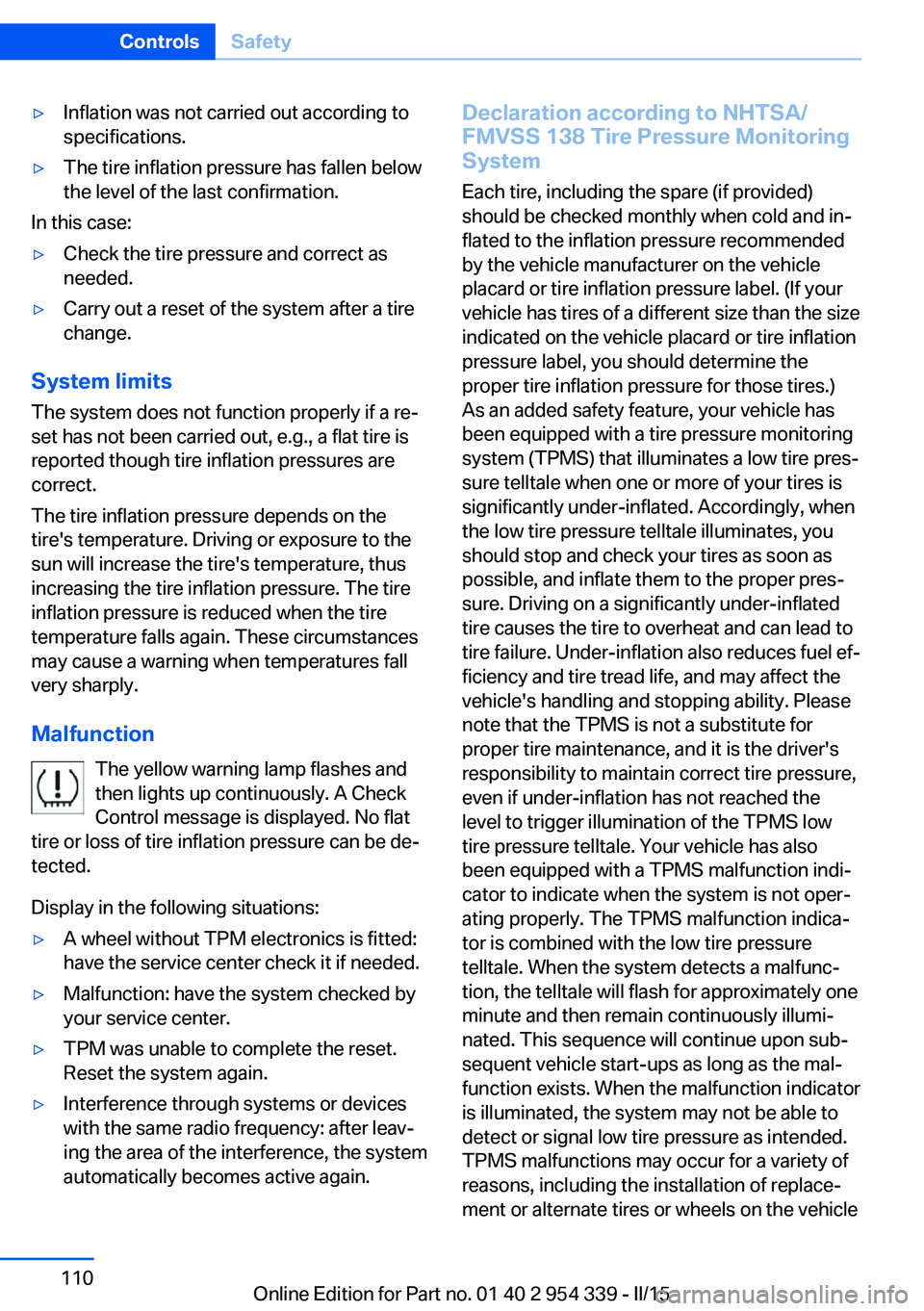
▷Inflation was not carried out according to
specifications.▷The tire inflation pressure has fallen below
the level of the last confirmation.
In this case:
▷Check the tire pressure and correct as
needed.▷Carry out a reset of the system after a tire
change.
System limits
The system does not function properly if a re‐
set has not been carried out, e.g., a flat tire is
reported though tire inflation pressures are
correct.
The tire inflation pressure depends on the
tire's temperature. Driving or exposure to the
sun will increase the tire's temperature, thus
increasing the tire inflation pressure. The tire
inflation pressure is reduced when the tire
temperature falls again. These circumstances
may cause a warning when temperatures fall
very sharply.
Malfunction The yellow warning lamp flashes and
then lights up continuously. A Check
Control message is displayed. No flat
tire or loss of tire inflation pressure can be de‐
tected.
Display in the following situations:
▷A wheel without TPM electronics is fitted:
have the service center check it if needed.▷Malfunction: have the system checked by
your service center.▷TPM was unable to complete the reset.
Reset the system again.▷Interference through systems or devices
with the same radio frequency: after leav‐
ing the area of the interference, the system
automatically becomes active again.Declaration according to NHTSA/
FMVSS 138 Tire Pressure Monitoring
System
Each tire, including the spare (if provided)
should be checked monthly when cold and in‐
flated to the inflation pressure recommended
by the vehicle manufacturer on the vehicle
placard or tire inflation pressure label. (If your
vehicle has tires of a different size than the size
indicated on the vehicle placard or tire inflation
pressure label, you should determine the
proper tire inflation pressure for those tires.)
As an added safety feature, your vehicle has
been equipped with a tire pressure monitoring
system (TPMS) that illuminates a low tire pres‐
sure telltale when one or more of your tires is
significantly under-inflated. Accordingly, when
the low tire pressure telltale illuminates, you
should stop and check your tires as soon as
possible, and inflate them to the proper pres‐
sure. Driving on a significantly under-inflated
tire causes the tire to overheat and can lead to
tire failure. Under-inflation also reduces fuel ef‐
ficiency and tire tread life, and may affect the
vehicle's handling and stopping ability. Please
note that the TPMS is not a substitute for
proper tire maintenance, and it is the driver's
responsibility to maintain correct tire pressure,
even if under-inflation has not reached the
level to trigger illumination of the TPMS low
tire pressure telltale. Your vehicle has also
been equipped with a TPMS malfunction indi‐
cator to indicate when the system is not oper‐
ating properly. The TPMS malfunction indica‐
tor is combined with the low tire pressure
telltale. When the system detects a malfunc‐
tion, the telltale will flash for approximately one
minute and then remain continuously illumi‐
nated. This sequence will continue upon sub‐
sequent vehicle start-ups as long as the mal‐
function exists. When the malfunction indicator
is illuminated, the system may not be able to
detect or signal low tire pressure as intended.
TPMS malfunctions may occur for a variety of
reasons, including the installation of replace‐
ment or alternate tires or wheels on the vehicleSeite 110ControlsSafety110
Online Edition for Part no. 01 40 2 954 339 - II/15
Page 182 of 239
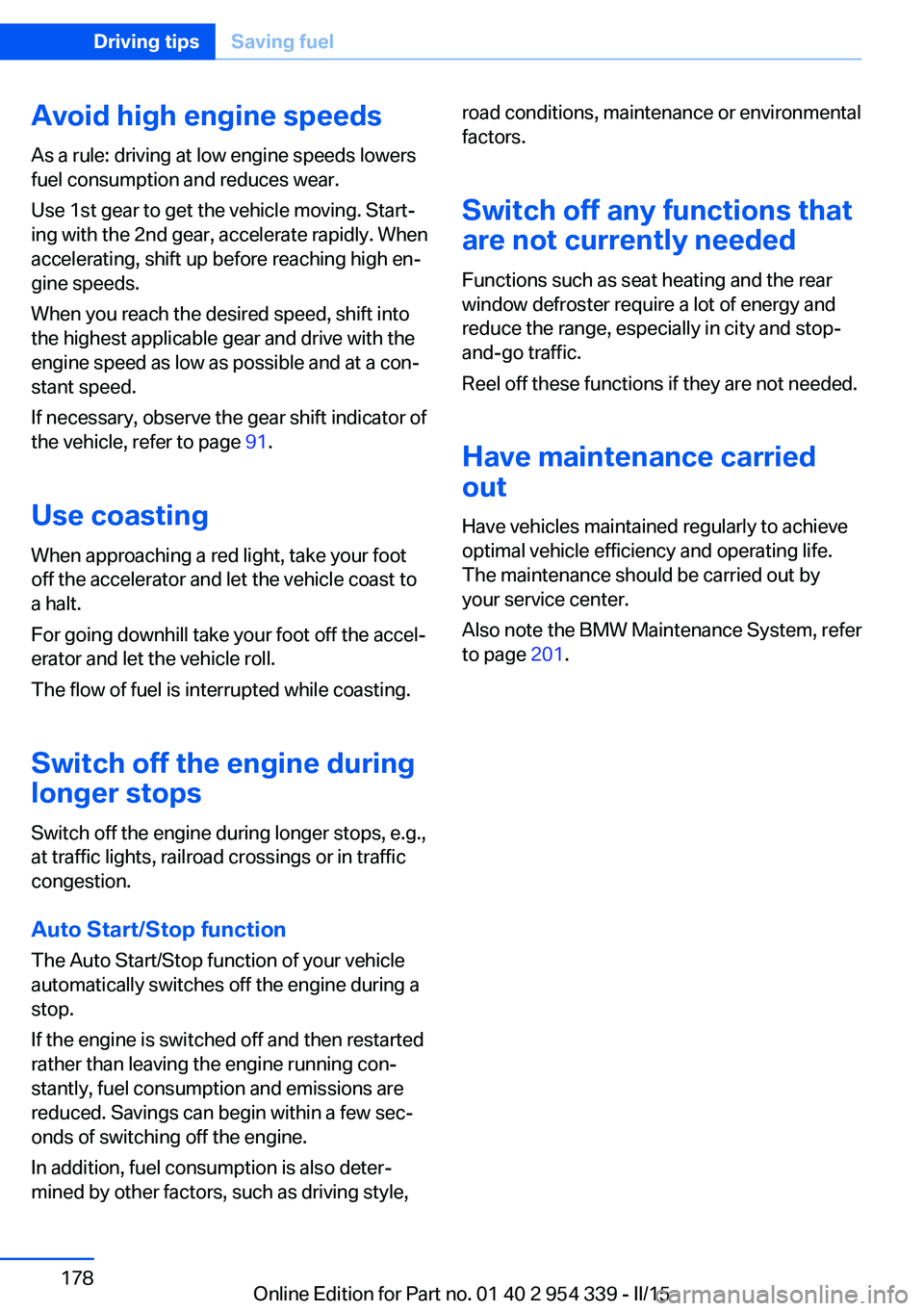
Avoid high engine speeds
As a rule: driving at low engine speeds lowers
fuel consumption and reduces wear.
Use 1st gear to get the vehicle moving. Start‐
ing with the 2nd gear, accelerate rapidly. When
accelerating, shift up before reaching high en‐
gine speeds.
When you reach the desired speed, shift into
the highest applicable gear and drive with the
engine speed as low as possible and at a con‐
stant speed.
If necessary, observe the gear shift indicator of
the vehicle, refer to page 91.
Use coasting
When approaching a red light, take your foot
off the accelerator and let the vehicle coast to
a halt.
For going downhill take your foot off the accel‐
erator and let the vehicle roll.
The flow of fuel is interrupted while coasting.
Switch off the engine during longer stops
Switch off the engine during longer stops, e.g.,
at traffic lights, railroad crossings or in traffic
congestion.
Auto Start/Stop function The Auto Start/Stop function of your vehicle
automatically switches off the engine during a
stop.
If the engine is switched off and then restarted
rather than leaving the engine running con‐
stantly, fuel consumption and emissions are
reduced. Savings can begin within a few sec‐
onds of switching off the engine.
In addition, fuel consumption is also deter‐
mined by other factors, such as driving style,road conditions, maintenance or environmental
factors.
Switch off any functions that
are not currently needed
Functions such as seat heating and the rear
window defroster require a lot of energy and
reduce the range, especially in city and stop-
and-go traffic.
Reel off these functions if they are not needed.
Have maintenance carried
out
Have vehicles maintained regularly to achieve
optimal vehicle efficiency and operating life.
The maintenance should be carried out by
your service center.
Also note the BMW Maintenance System, refer
to page 201.Seite 178Driving tipsSaving fuel178
Online Edition for Part no. 01 40 2 954 339 - II/15
Page 210 of 239
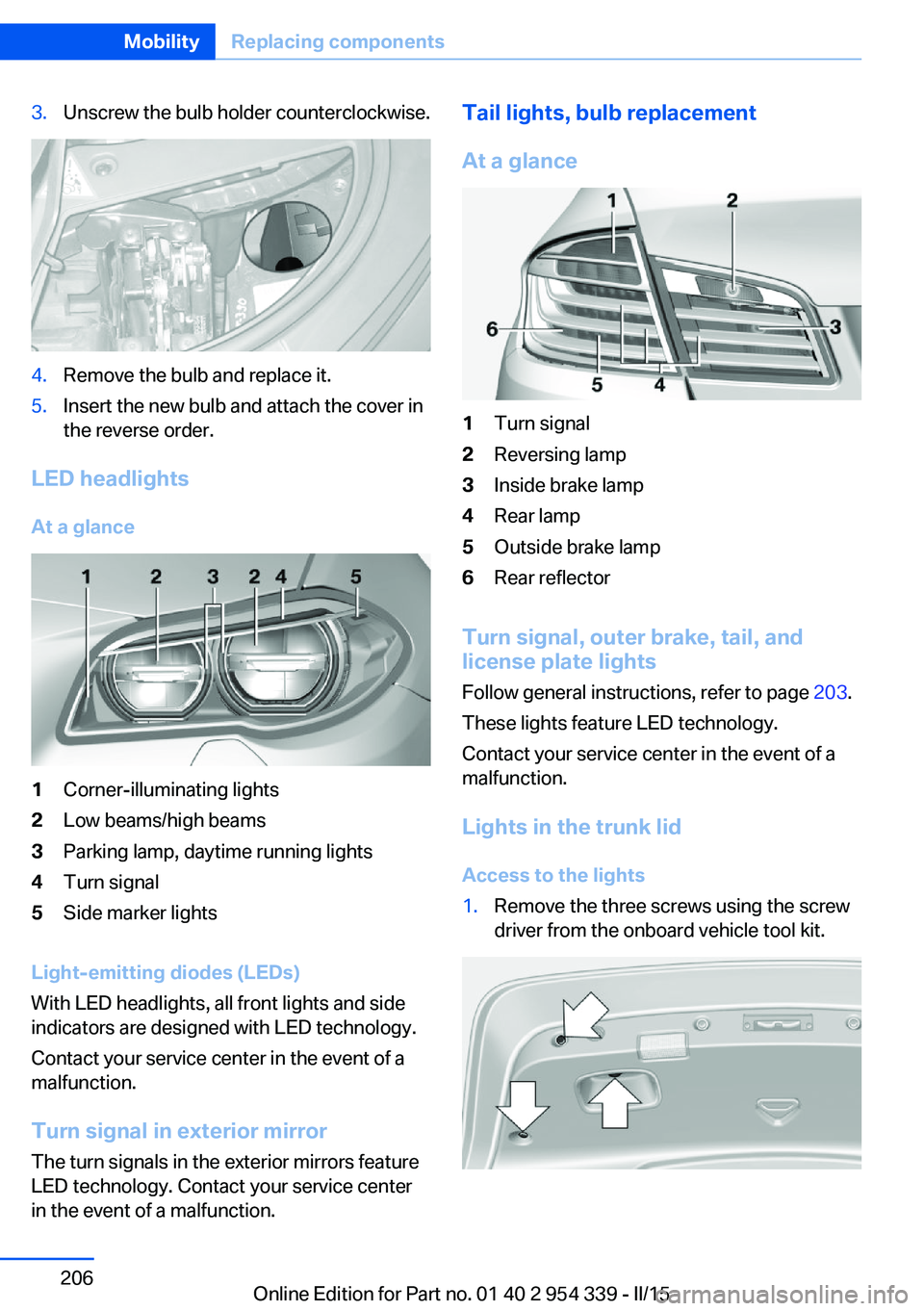
3.Unscrew the bulb holder counterclockwise.4.Remove the bulb and replace it.5.Insert the new bulb and attach the cover in
the reverse order.
LED headlights
At a glance
1Corner-illuminating lights2Low beams/high beams3Parking lamp, daytime running lights4Turn signal5Side marker lights
Light-emitting diodes (LEDs)
With LED headlights, all front lights and side
indicators are designed with LED technology.
Contact your service center in the event of a
malfunction.
Turn signal in exterior mirrorThe turn signals in the exterior mirrors feature
LED technology. Contact your service center
in the event of a malfunction.
Tail lights, bulb replacement
At a glance1Turn signal2Reversing lamp3Inside brake lamp4Rear lamp5Outside brake lamp6Rear reflector
Turn signal, outer brake, tail, and
license plate lights
Follow general instructions, refer to page 203.
These lights feature LED technology.
Contact your service center in the event of a
malfunction.
Lights in the trunk lid
Access to the lights
1.Remove the three screws using the screw
driver from the onboard vehicle tool kit.Seite 206MobilityReplacing components206
Online Edition for Part no. 01 40 2 954 339 - II/15
Page 232 of 239
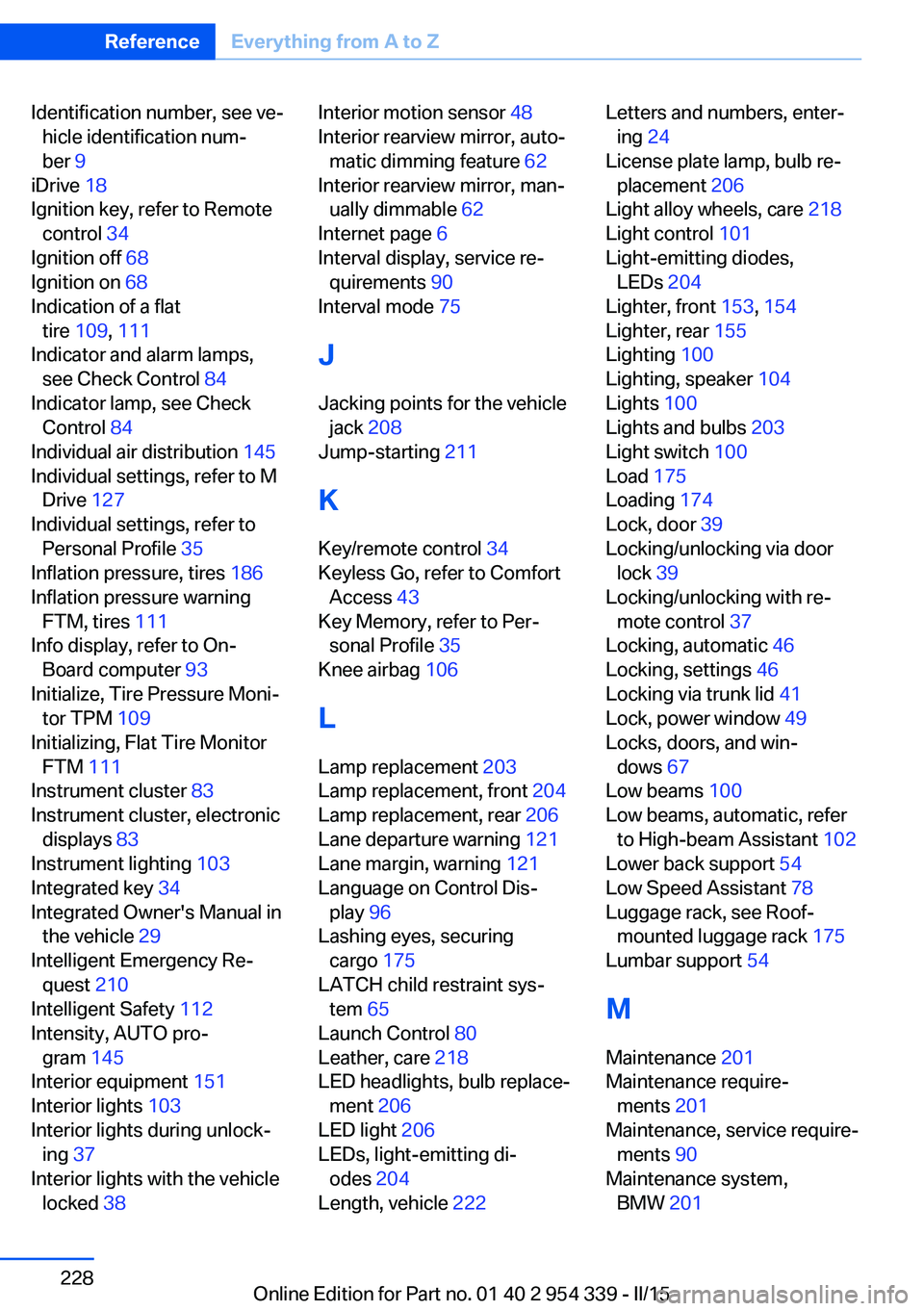
Identification number, see ve‐hicle identification num‐
ber 9
iDrive 18
Ignition key, refer to Remote control 34
Ignition off 68
Ignition on 68
Indication of a flat tire 109 , 111
Indicator and alarm lamps, see Check Control 84
Indicator lamp, see Check Control 84
Individual air distribution 145
Individual settings, refer to M Drive 127
Individual settings, refer to Personal Profile 35
Inflation pressure, tires 186
Inflation pressure warning FTM, tires 111
Info display, refer to On- Board computer 93
Initialize, Tire Pressure Moni‐ tor TPM 109
Initializing, Flat Tire Monitor FTM 111
Instrument cluster 83
Instrument cluster, electronic displays 83
Instrument lighting 103
Integrated key 34
Integrated Owner's Manual in the vehicle 29
Intelligent Emergency Re‐ quest 210
Intelligent Safety 112
Intensity, AUTO pro‐ gram 145
Interior equipment 151
Interior lights 103
Interior lights during unlock‐ ing 37
Interior lights with the vehicle locked 38 Interior motion sensor 48
Interior rearview mirror, auto‐ matic dimming feature 62
Interior rearview mirror, man‐ ually dimmable 62
Internet page 6
Interval display, service re‐ quirements 90
Interval mode 75
J Jacking points for the vehicle jack 208
Jump-starting 211
K
Key/remote control 34
Keyless Go, refer to Comfort Access 43
Key Memory, refer to Per‐ sonal Profile 35
Knee airbag 106
L Lamp replacement 203
Lamp replacement, front 204
Lamp replacement, rear 206
Lane departure warning 121
Lane margin, warning 121
Language on Control Dis‐ play 96
Lashing eyes, securing cargo 175
LATCH child restraint sys‐ tem 65
Launch Control 80
Leather, care 218
LED headlights, bulb replace‐ ment 206
LED light 206
LEDs, light-emitting di‐ odes 204
Length, vehicle 222 Letters and numbers, enter‐
ing 24
License plate lamp, bulb re‐ placement 206
Light alloy wheels, care 218
Light control 101
Light-emitting diodes, LEDs 204
Lighter, front 153, 154
Lighter, rear 155
Lighting 100
Lighting, speaker 104
Lights 100
Lights and bulbs 203
Light switch 100
Load 175
Loading 174
Lock, door 39
Locking/unlocking via door lock 39
Locking/unlocking with re‐ mote control 37
Locking, automatic 46
Locking, settings 46
Locking via trunk lid 41
Lock, power window 49
Locks, doors, and win‐ dows 67
Low beams 100
Low beams, automatic, refer to High-beam Assistant 102
Lower back support 54
Low Speed Assistant 78
Luggage rack, see Roof- mounted luggage rack 175
Lumbar support 54
M
Maintenance 201
Maintenance require‐ ments 201
Maintenance, service require‐ ments 90
Maintenance system, BMW 201 Seite 228ReferenceEverything from A to Z228
Online Edition for Part no. 01 40 2 954 339 - II/15
Page 235 of 239
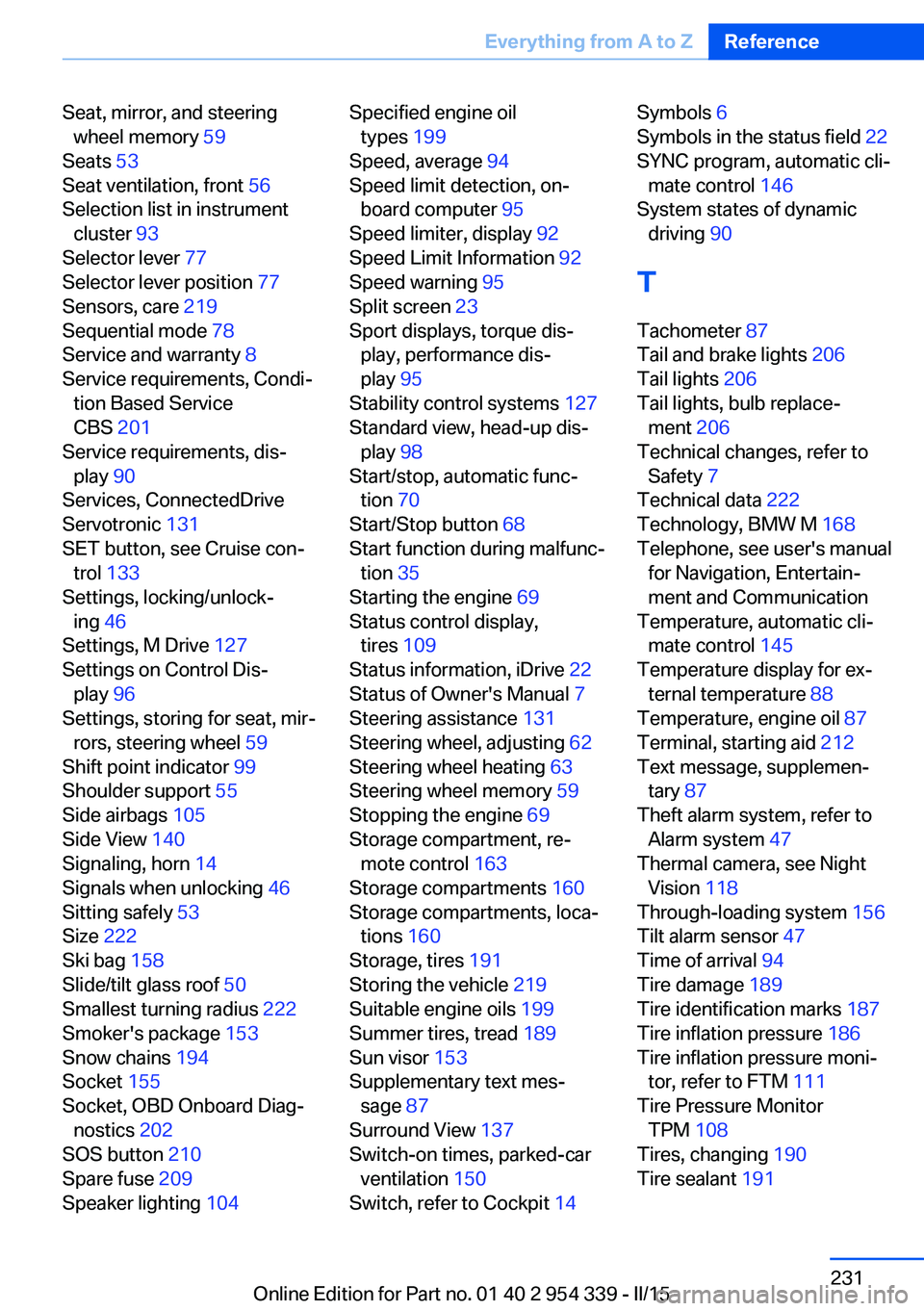
Seat, mirror, and steeringwheel memory 59
Seats 53
Seat ventilation, front 56
Selection list in instrument cluster 93
Selector lever 77
Selector lever position 77
Sensors, care 219
Sequential mode 78
Service and warranty 8
Service requirements, Condi‐ tion Based Service
CBS 201
Service requirements, dis‐ play 90
Services, ConnectedDrive
Servotronic 131
SET button, see Cruise con‐ trol 133
Settings, locking/unlock‐ ing 46
Settings, M Drive 127
Settings on Control Dis‐ play 96
Settings, storing for seat, mir‐ rors, steering wheel 59
Shift point indicator 99
Shoulder support 55
Side airbags 105
Side View 140
Signaling, horn 14
Signals when unlocking 46
Sitting safely 53
Size 222
Ski bag 158
Slide/tilt glass roof 50
Smallest turning radius 222
Smoker's package 153
Snow chains 194
Socket 155
Socket, OBD Onboard Diag‐ nostics 202
SOS button 210
Spare fuse 209
Speaker lighting 104 Specified engine oil
types 199
Speed, average 94
Speed limit detection, on- board computer 95
Speed limiter, display 92
Speed Limit Information 92
Speed warning 95
Split screen 23
Sport displays, torque dis‐ play, performance dis‐
play 95
Stability control systems 127
Standard view, head-up dis‐ play 98
Start/stop, automatic func‐ tion 70
Start/Stop button 68
Start function during malfunc‐ tion 35
Starting the engine 69
Status control display, tires 109
Status information, iDrive 22
Status of Owner's Manual 7
Steering assistance 131
Steering wheel, adjusting 62
Steering wheel heating 63
Steering wheel memory 59
Stopping the engine 69
Storage compartment, re‐ mote control 163
Storage compartments 160
Storage compartments, loca‐ tions 160
Storage, tires 191
Storing the vehicle 219
Suitable engine oils 199
Summer tires, tread 189
Sun visor 153
Supplementary text mes‐ sage 87
Surround View 137
Switch-on times, parked-car ventilation 150
Switch, refer to Cockpit 14 Symbols 6
Symbols in the status field 22
SYNC program, automatic cli‐ mate control 146
System states of dynamic driving 90
T
Tachometer 87
Tail and brake lights 206
Tail lights 206
Tail lights, bulb replace‐ ment 206
Technical changes, refer to Safety 7
Technical data 222
Technology, BMW M 168
Telephone, see user's manual for Navigation, Entertain‐
ment and Communication
Temperature, automatic cli‐ mate control 145
Temperature display for ex‐ ternal temperature 88
Temperature, engine oil 87
Terminal, starting aid 212
Text message, supplemen‐ tary 87
Theft alarm system, refer to Alarm system 47
Thermal camera, see Night Vision 118
Through-loading system 156
Tilt alarm sensor 47
Time of arrival 94
Tire damage 189
Tire identification marks 187
Tire inflation pressure 186
Tire inflation pressure moni‐ tor, refer to FTM 111
Tire Pressure Monitor TPM 108
Tires, changing 190
Tire sealant 191 Seite 231Everything from A to ZReference231
Online Edition for Part no. 01 40 2 954 339 - II/15